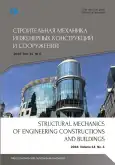Adjustment of forces in large-span structures in the design of a rational constructive form of a Dolphinarium in Volgograd
- 作者: Sitnikov I.R1, Golikov A.V1
-
隶属关系:
- Volgograd State Technical University
- 期: 卷 14, 编号 4 (2018)
- 页面: 278-292
- 栏目: Analysis and design of building structures
- URL: https://journal-vniispk.ru/1815-5235/article/view/346326
- DOI: https://doi.org/10.22363/1815-5235-2018-14-4-278-292
- ID: 346326
如何引用文章
全文:
详细
In some cases, architectural, technological or other special requirements dictate the development of buildings and structures with large spans of shells. The choice of the scheme of bearing structures depends on the size of the span, architectural and planning solutions, the shape of the building in plan, the height of the structure, the presence and type of suspended transport, the requirements for the rigidity of the shell, the nature of lighting and aeration, type of roof, size and distribution of loads, the need to accommodate large masses of people and other factors. Differences in the purpose of large-span buildings and structures, features of technological processes, architectural and aesthetic requirements determine the use of a variety of solutions of such coatings. The article presents design measures for the implementation of architectural and artistic solutions of the building of the Dolphinarium in Volgograd. Analytical description of complex architectural and structural forms is performed. The analysis of existing structural forms of large-span structures is given. In the design, the concept of a combined archcable system was implemented, in which the cable system acts as an unloading and supporting system. The study of the work under load of various schemes of the cable system. It was also investigated the influence of pre-tensioning braces on strain supported their designs, and from what was determined optimal value of the efforts of the cables tension.
作者简介
Ivan Sitnikov
Volgograd State Technical University
编辑信件的主要联系方式.
Email: sitnikovir11@gmail.com
Master’s Degree Student of the Department of Building Structures, Foundations and Reliability of Structures, Volgograd State Technical University. Research interests: building structures, metal structures, design of large-span and prestressed structures
28 Lenin Avenue, Volgograd, 400131, Russian FederationAlexander Golikov
Volgograd State Technical University
Email: alexandr_golikov@mail.ru
Cand. Sci. (Eng.), Associate Professor of the Department of Building Structures, Foundations and Reliability of Structures, Volgograd State Technical University. Research interests: building structures, metal structures, design of large-span, tower, sheet and prestressed structures, reliability of building structures
28 Lenin Avenue, Volgograd, 400131, Russian Federation参考
- Kuznecov V.V. (1998). Spravochnik proektirovshhika. Metallicheskie konstrukcii. Tom 2. Stal'nye konstrukcii zdanij i sooruzhenij [Directory of the designer. Metal construction. Volume 2. Steel structures of buildings and structures]. Moscow, ASV Publ., 512. (In Russ.)
- Gorev V.V. (2002). Metallicheskie konstrukcii. Tom 2. Konstrukcii zdanij [Metal construction. Volume 2. Building structure]. Moscow, Vysshaya shkola Publ., 528. (In Russ.)
- Belenja E.I. (1986). Metallicheskie konstrukcii. Obshhij kurs [Metal construction. General course]. Moscow, Strojizdat Publ., 560. (In Russ.)
- Mel'nikov N.P. (1980). Spravochnik proektirovshhika. Metallicheskie konstrukcii [Directory of the designer. Metal construction]. Moscow, Strojizdat Publ., 776. (In Russ.)
- Kancheli V.N. (2003). Stroitel'nye prostranstvennye konstrukcii. Uchebnoe posobie [Building spatial constructions. A tutorial]. Moscow, ASV Publ., 112. (In Russ.)
- Eremeev P.G. (2013). Metal spatial constructions of unique large-span structures in Russia. Promyshlennoe i grazhdanskoe stroitelstvo [Industrial and civil engineering], (10), 9–14. (In Russ.)
- Eremeev P.G. (2009). Razrabotka, issledovanie, proektirovanie i vozvedenie bol'sheproletnyh metallicheskih konstrukcij unikal'nyh zdanij i sooruzhenij [Development, research, design and construction of large-span metal structures of unique buildings and structures]. Vestnik NIC Stroitel'stvo, (1), 107–122. (In Russ.)
- Dushkevich K.N., Suslova O.Ju. (2014). Sovremennye bol'sheproletnye konstrukcii [Modern large-span structures]. Nauka, obrazovanie i jeksperimental'noe proektirovanie. Tezisy dokladov Mezhdunarodnoj nauchnoprakticheskoj konferencii professorsko-prepodavatel'skogo sostava, molodyh uchenyh i studentov, 7–14 aprelya. [Science, education and experimental design. Theses of the International scientific research conference of professorial teaching staff, young researchers and students, 7–14 April]. Moscow, MARHI Publ., 385–386. (In Russ.)
- Sysoeva E.V. (2017). Scientific approaches to the calculation and design of large-span structures. Vestnik MGSU, (2), 131–141. (In Russ.)
- Grishanovich A.I. (2016). Varianty primeneniya unikal'nyh konstrukcij pokrytiya dlya bol'sheproletnyh sportivnyh sooruzhenij [Options for the use of unique coating designs for large-span sports facilities]. Gradostroitel'stvo, infrastruktura, kommunikacii, (2), 45–51. (In Russ.)
- Cai J., Feng J., Jiang Ch. (2014). Development and analysis of a long-span retractable roof structure. Journal of Constructional Steel Research, (92), 175–182.
- Buhanan P. (2000). Renzo Piano Building Workshop. Volume 3. Phaidon, 240.
- Makowski Z.S. (1984). Analysis, Design and Construction of Braced Domes. Granada, University of Surrey, UK.
- Ballio G., Mazzolani F.M. (2008). Theory and Design of Steel Structures. Taylor & Francis, 576.
- McCormac J.C., Csernak S.F. (2012). Structural steel design. Fifth edition. Pearson Education Limited, 723.
- Barnes M., Dickson M. (2000). Widespan roof structures. London, Thomas Telford Publishing Ltd., 328.
- John F. Abel. (2011). The future of spatial structures. Fifty Years of Progress for Shell and Spatial Structures. Brentwood, UK, Multi Science Publishing Co Ltd., 485–490.
- Chilton J. (2000). Space Grid Structures. Architectural Press, 191.
- Eremeev P.G., Kiselev D.B. (2005). Sovremennye arochno-vantovye kombinirovannye konstrukcii [Modern arch-cable-stayed combined constructions]. Montazhnye i special'nye raboty v stroitel'stve [Assembly and special works in construction], (9), 11–16. (In Russ.)
- Demchenko A.I. (2014). Vantovye konstrukcii [Cable-stayed structures]. Mezhdunarodnaja nauchnotehnicheskaja konferencija molodyh uchenyh BGTU im. V.G. Shukhova [International scientific conference of Shukhov BSTU young scientists]. Belgorod, Shukhov BSTU Publ., 199–202. (In Russ.)
- Simiu Je., Skanlan R. (1984). Vozdejstvie vetra na zdanija i sooruzhenija [Wind impact on buildings and structures]. Мoscow, Strojizdat Publ., 360. (In Russ.)
- Martins N., Caetano E., Diord S., Magalhães F., Cunha Á. (2014). Dynamic monitoring of a stadium suspension roof: Wind and temperature influence on modal parameters and structural response. Engineering Structures, (59), 80–94.
- Ding Zh., Tamura Y. (2013). Contributions of wind-induced overall and local behaviors for internal forces in cladding support components of large-span roof structure. Journal of Wind Engineering and Industrial Aerodynamics, (115), 162–172.
补充文件









